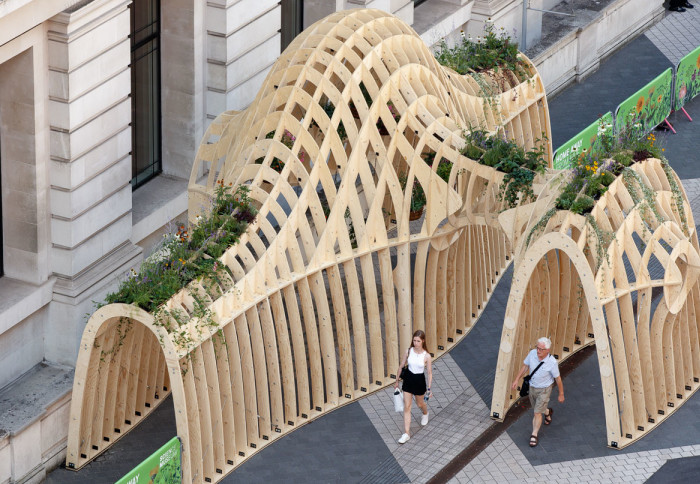Going green and healthy competition: News from the College

The Home Away from Hive installation (Credit: Luke O'Donovan)
Here’s a batch of fresh news and announcements from across Imperial.
From a new series of ‘green intervention’ installations in South Kensington, to studying the importance of mitochondrial competition, here is some quick-read news from across the College.
Going green

Art and science have come together in the new South Ken Green Trail, a series of installations created to welcome people and nature back to Exhibition Road.
An algae factory, a nest-like timber mound and giant slices of a decommissioned wind turbine blade form the series of ‘green interventions’ which will be in place outside the Natural History Museum, Science Museum and Imperial until mid-October
Together they support the post-pandemic recovery of the district, and demonstrate how plants, greenery and biodiversity can be creatively embedded in London’s public realm.
A new walking trail connects them with other planting and green spaces around South Kensington.
Download the trail map to explore and discover hidden nature around the area and take part in the events and activities happening throughout the summer.
Plasma physics award

Professor Matthew Foulkes, together with an international team of collaborators, has been awarded the American Physical Society’s John Dawson Award for Excellence in Plasma Physics Research “for developing Monte Carlo methods that overcome the fermion sign problem, leading to the first ab initio data for an electron gas under warm dense matter conditions.”
Professor Foulkes said: “As a condensed matter physicist with little knowledge of plasma physics, I was as astonished as I was delighted to learn that I was one of the winners of the 2021 John Dawson Award for Excellence in Plasma Physics.
“One of the other winners, Fionn Malone, was one of the first Imperial College President's PhD Scholars and did this work as his PhD project! I was lucky that he chose me as his supervisor.”
For more information on all the recipients, see the APS Honors webpage.
Healthy competition breeds success
![]() Disorders caused by mitochondrial DNA mutations affect about 1 in 4,000 people. Research led by Dr Ana Lima working with Dr Tristan Rodríguez, of the National Heart and Lung Institute, shows that early embryo cells with different mitochondrial activity compete with each other, so that those with mitochondrial dysfunction are eliminated. This competition acts as quality control to ensure that only the fittest cells go on to form the foetus and prevents mitochondrial DNA mutations from passing to the next generation.
Disorders caused by mitochondrial DNA mutations affect about 1 in 4,000 people. Research led by Dr Ana Lima working with Dr Tristan Rodríguez, of the National Heart and Lung Institute, shows that early embryo cells with different mitochondrial activity compete with each other, so that those with mitochondrial dysfunction are eliminated. This competition acts as quality control to ensure that only the fittest cells go on to form the foetus and prevents mitochondrial DNA mutations from passing to the next generation.
Mitochondrial dysfunction and mutations in the mitochondrial DNA arising during embryo development can cause mitochondrial diseases, that cause various symptoms including poor growth, neurological disorders and heart disease. But how these mechanisms act at the molecular level was poorly understood, until now.
(Image caption: Normal mouse embryonic stem cells with active mitochondria (labelled in red) can recognise defective cells (labelled in green), that have poor mitochondrial function, and trigger their elimination from the stem cell pool. Scale bar = 5 μm. Image credit: Ana Lima)
–
Want to be kept up to date on news at Imperial?
Sign up for our free quick-read daily e-newsletter, Imperial Today.

Article text (excluding photos or graphics) © Imperial College London.
Photos and graphics subject to third party copyright used with permission or © Imperial College London.
Reporter
Andrew Youngson
Communications Division
Ms Helen Johnson
Communications Division
Hayley Dunning
Communications Division